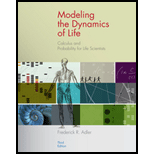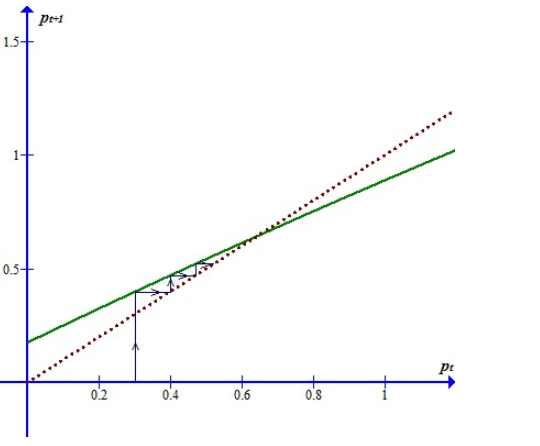
a
To calculate: To find the number of butterflies after migration and after reproduction using the given values
a
Answer to Problem 38E
There are
Explanation of Solution
Given information: Each year, 20% of the butterflies from the first island fly to the second and 30% of the butterflies from the second fly to the first.
Calculation:
Let us consider the following situation. There are two nearby islands which have populations of butterflies, with
Let
Consider the first island. In the beginning there are 100 butterflies out of which 20 migrate to the second island and 30 migrate from the second island to the first island.
Hence, there are
Now consider the second island. In the beginning there are 100 butterflies out of which 30 migrate to the first island and 20 migrate from the first island to the second island.
Hence, there are
Again consider the first island. Now there are 190 butterflies out of which 38 migrate to the second island and 33 migrate from the second island to the first island.
Hence, there are
Now consider the second island- In the beginning there are 110 butterflies out of which 33 migrate to the first island and 38 migrate from the first island to the second island.
Hence, there are
b
To calculate: To find the equations of
b
Answer to Problem 38E
Explanation of Solution
Given information: Each year, 20% of the butterflies from the first island fly to the second and 30% of the butterflies from the second fly to the first.
Calculation:
Now the equation for
Also, the equation for
c
To calculate: To find the discrete-time dynamical system for
c
Answer to Problem 38E
Explanation of Solution
Given information: Each year, 20% of the butterflies from the first island fly to the second and 30% of the butterflies from the second fly to the first.
Calculation:
To find the discrete-time dynamical system for
d
To calculate: To find the equilibrium of
d
Answer to Problem 38E
Using the
This is larger because the butterflies from the first island reproduce.
Explanation of Solution
Given information: Each year, 20% of the butterflies from the first island fly to the second and 30% of the butterflies from the second fly to the first.
Calculation:
To find the equilibrium
Now using the quadratic formula, we get
This is larger than the result in exercise 36 because the butterflies from the first island reproduce.
e
To calculate: To draw the graph using the obtained values
e
Answer to Problem 38E
Hence the graph is drawn using the obtained values.
Explanation of Solution
Given information: Each year, 20% of the butterflies from the first island fly to the second and 30% of the butterflies from the second fly to the first.
Calculation:
The graph along with the cobweb is shown below

Want to see more full solutions like this?
Chapter 1 Solutions
Modeling the Dynamics of Life: Calculus and Probability for Life Scientists
- In Exercises 1 through 3, let xo = O and calculate P7(x) and R7(x). 1. f(x)=sin x, x in R. 2. f(x) = cos x, x in R. 3. f(x) = In(1+x), x≥0. 4. In Exercises 1, 2, and 3, for |x| 1, calculate a value of n such that P(x) approximates f(x) to within 10-6. 5. Let (an)neN be a sequence of positive real numbers such that L = lim (an+1/an) exists in R. If L < 1, show that an → 0. [Hint: Let 1111 Larrow_forwardiation 7. Let f be continuous on [a, b] and differentiable on (a, b). If lim f'(x) xia exists in R, show that f is differentiable at a and f'(a) = lim f'(x). A similar result holds for b. x-a 8. In reference to Corollary 5.4, give an example of a uniformly continuous function on [0, 1] that is differentiable on (0, 1] but whose derivative is not bounded there. 9. Recall that a fixed point of a function f is a point c such that f(c) = c. (a) Show that if f is differentiable on R and f'(x)| x if x 1 and hence In(1+x) 0. 12. For 0 л/2. (Thus, as x л/2 from the left, cos x is never large enough for x+cosx to be greater than л/2 and cot x is never small enough for x + cot x to be less than x/2.)arrow_forward1. Show that f(x) = x3 is not uniformly continuous on R. 2. Show that f(x) = 1/(x-2) is not uniformly continuous on (2,00). 3. Show that f(x)=sin(1/x) is not uniformly continuous on (0,л/2]. 4. Show that f(x) = mx + b is uniformly continuous on R. 5. Show that f(x) = 1/x2 is uniformly continuous on [1, 00), but not on (0, 1]. 6. Show that if f is uniformly continuous on [a, b] and uniformly continuous on D (where D is either [b, c] or [b, 00)), then f is uniformly continuous on [a, b]U D. 7. Show that f(x)=√x is uniformly continuous on [1, 00). Use Exercise 6 to conclude that f is uniformly continuous on [0, ∞). 8. Show that if D is bounded and f is uniformly continuous on D, then fis bounded on D. 9. Let f and g be uniformly continuous on D. Show that f+g is uniformly continuous on D. Show, by example, that fg need not be uniformly con- tinuous on D. 10. Complete the proof of Theorem 4.7. 11. Give an example of a continuous function on Q that cannot be continuously extended to R. 12.…arrow_forwardcan I see the steps for how you got the same answers already provided for μ1->μ4. this is a homework that provide you answers for question after attempting it three triesarrow_forward1. Prove that for each n in N, 1+2++ n = n(n+1)/2. 2. Prove that for each n in N, 13 +23+ 3. Prove that for each n in N, 1+3+5+1 4. Prove that for each n ≥ 4,2" -1, then (1+x)" ≥1+nx for each n in N. 11. Prove DeMoivre's Theorem: fort a real number, (cost+i sint)" = cos nt + i sinnt for each n in N, where i = √√-1.arrow_forwardPls help ASAParrow_forward2. Sam and Deb have a weekly net income of $1500. They have a pet dog. Their monthly expenses, not related to housing, are $2875. They have savings of $32 000. They are considering two housing options: Option 1: Renting a 2-bedroom condo for $1650 a month, plus utilities averaging $210 a month Option 2: Buying a 2-bedroom condo for a down payment of $24 500, bi-weekly mortgage payments of $1100, and a monthly condo fee of $475 a) Determine the monthly cost of each housing option. Factoring in other expenses not related to housing, which one can Sam and Deb afford? b) Suppose their dog falls ill and they have to pay $85 every week to cover veterinarian and medical expenses. Calculate the additional monthly expenses. How much money would be available for savings if they choose housing option 2?arrow_forwardI bought sparrows at 3 for a penny, turtle doves at 2 for a penny, anddoves at 2 pence each. If I spent 30 pence buying 30 birds and boughtat least one of each kind of bird, how many birds of each kind did I buy?(This is a problem from Fibonacci’s Liber Abaci, 1202.)arrow_forward2. Jacob is going to college. He has a part-time job with take-home pay of $575 every two weeks. He has received a scholarship for $5500 for the year. Determine Jacob's total monthly income.arrow_forward1. Pira's expenses are $850 a month for rent and utilities, $52 a month for TV and Internet package, $90 a week for food, $110 a month for a bus pass, $25 a week for entertainment, and $85 every two weeks for miscellaneous expenses. a) Convert each expense to a monthly amount and represent each monthly amount as a percentage. b) Create a circle graph that shows the breakdown of the monthly expenses. c) Pira has an income of $1600/biweekly and is deciding whether a weeklong vacation to Florida would be within her budget. The cost of the trip is approximately $2000 per week. Would you recommend for her to take the one weeklong vacation? Explain.arrow_forward4. Mason works at a part-time job earning $985 every two weeks. Mason's expenses are $750 a month for rent and utilities, $75 a month for her cell phone, $350 a month for food, $35 a week for entertainment, $310 a month for her car loan payment, and $65 every two weeks for miscellaneous expenses. How long will it take Mason to save $2000 for a vacation? Round your answer to the nearest month.arrow_forwardPls help ASAParrow_forwardarrow_back_iosSEE MORE QUESTIONSarrow_forward_ios
 Trigonometry (MindTap Course List)TrigonometryISBN:9781337278461Author:Ron LarsonPublisher:Cengage Learning
Trigonometry (MindTap Course List)TrigonometryISBN:9781337278461Author:Ron LarsonPublisher:Cengage Learning Algebra for College StudentsAlgebraISBN:9781285195780Author:Jerome E. Kaufmann, Karen L. SchwittersPublisher:Cengage Learning
Algebra for College StudentsAlgebraISBN:9781285195780Author:Jerome E. Kaufmann, Karen L. SchwittersPublisher:Cengage Learning Intermediate AlgebraAlgebraISBN:9781285195728Author:Jerome E. Kaufmann, Karen L. SchwittersPublisher:Cengage Learning
Intermediate AlgebraAlgebraISBN:9781285195728Author:Jerome E. Kaufmann, Karen L. SchwittersPublisher:Cengage Learning
 Holt Mcdougal Larson Pre-algebra: Student Edition...AlgebraISBN:9780547587776Author:HOLT MCDOUGALPublisher:HOLT MCDOUGAL
Holt Mcdougal Larson Pre-algebra: Student Edition...AlgebraISBN:9780547587776Author:HOLT MCDOUGALPublisher:HOLT MCDOUGAL Glencoe Algebra 1, Student Edition, 9780079039897...AlgebraISBN:9780079039897Author:CarterPublisher:McGraw Hill
Glencoe Algebra 1, Student Edition, 9780079039897...AlgebraISBN:9780079039897Author:CarterPublisher:McGraw Hill





